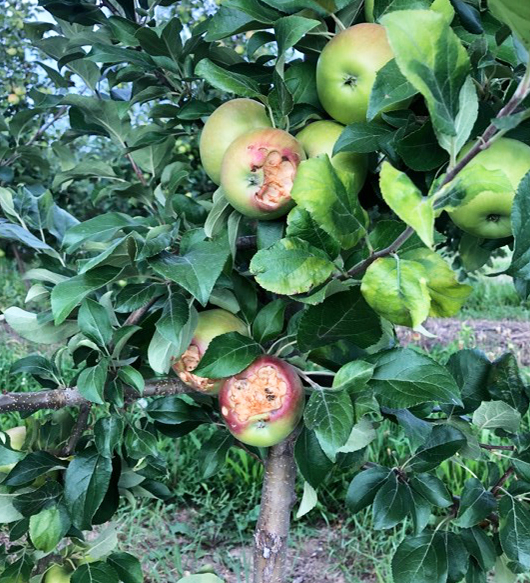Northwest Michigan fruit update – Aug. 13, 2019
Tart cherry harvest is winding down and apple pest activity has picked up.

Apple maggot activity was reported in the region late last week and our first detection of this pest at the Northwest Michigan Horticulture Research Center was today (Aug. 13)—we found a total of three apple maggots on a baited red sphere trap. There is a pre-oviposition period seven-to-10 days after apple maggot flies emerge when treatments for this pest should be made. Apple maggots were likely active over the weekend, so making an application within the week would be a safer option to prevent damage.
We observed an uptick in codling moth activity at the station this week and received reports that codling moth numbers increased over the last few days in orchards where numbers had been low for a few weeks. We have not observed distinct flights that would indicate second generation flight, and therefore we are following our original biofix date of June 8. Since biofix, we have accumulated 1,317 growing degree days (GDD) base 50, indicating that eggs from second generation moths are hatching at this time. The treatment threshold for second generation codling moth is lower, a cumulative catch of three to five moths in a single trap.
The second emergence of black stem borer is underway in the region. This pest has two emergence periods per season—one in spring and one in summer. We found a total of three beetles in our trap at the station and we have received reports that black stem borer activity picked up in hot spot orchards over the last week. We have not observed trees at the station with black stem borer infestation and our trap numbers have been lower in comparison to blocks that have experienced tree losses associated with this pest.
The second flight of San Jose scale males is underway and we have found traps placed in sweet cherry blocks with thousands of scale on them. Interestingly, we also observed crawler activity in sweet cherry this week, and in blocks with high populations, crawlers and newly settled scales have not been difficult to find. Hence, there seems to be an overlap in the different life stages of scale this season. Traps in apples at the station also have high numbers of male scales this week. We have continued to find new damage (i.e., red circular rings surrounding the settled scale) on apple fruit at the station.
We have received reports that all stages of European red mites can be found in the region, but populations have continued to be low at the station. Some bronzing form mite damage is noticeable.

Japanese beetle feeding and mating activity is ongoing and new feeding damage called skeletonizing is evident. These beetles have a broad host range and will feed on all tree fruits, small fruits and ornamentals. The beetles will likely continue to be active for a few more weeks.
We have not detected brown marmorated stink bugs in traps, but this pest has been observed in residential areas.
Feeding damage from turkeys can be found on lower limbs in Honeycrisp at the station (see photo). We also suspect porcupine damage in our high-density sweet cherries.
Tart cherry harvest is winding down and growers have continued to make post-harvest applications for cherry leaf spot. We have received reports of hot spot areas of spider mites with bronzing and firing in areas with high mite populations.



 Print
Print Email
Email